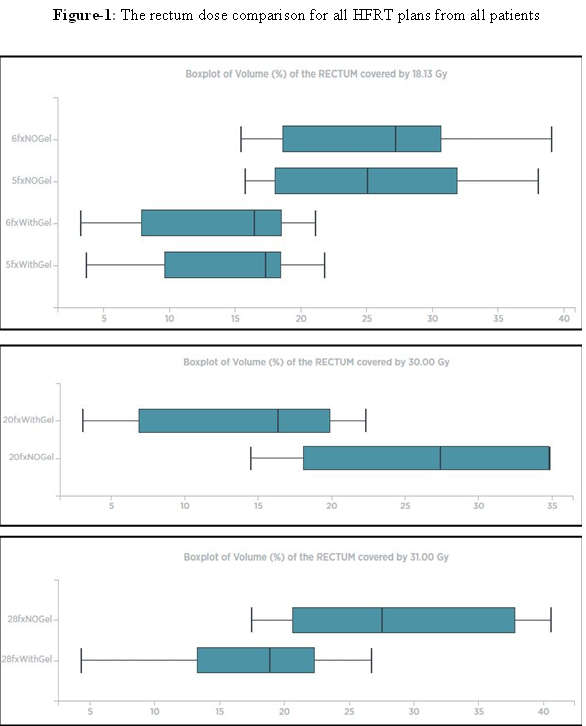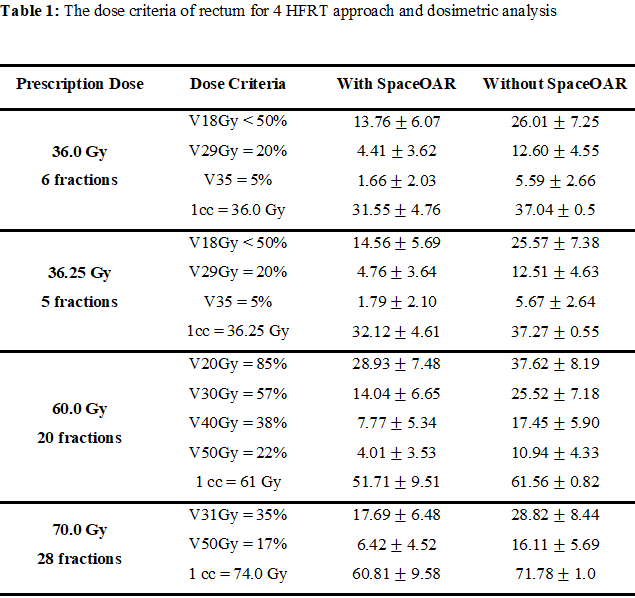Hypo-fractionated radiotherapy with SpaceOAR for prostate cancer treated with Radixact TomoTherapy
PO-1818
Abstract
Hypo-fractionated radiotherapy with SpaceOAR for prostate cancer treated with Radixact TomoTherapy
Authors: Sumeyra Can1, Didem Karaçetin2, Hamza Tatlı3, Özge Atilla1, Nilgül Nalbant1
1Basaksehir Cam and Sakura City Hospital, Radiation Oncology, Istanbul, Turkey; 2Basaksehir Cam and Sakura City Hospital , Radiation Oncology, Istanbul, Turkey; 3Elekta Instrument Turkiye, İstanbul Liaison Office, Istanbul, Turkey
Show Affiliations
Hide Affiliations
Purpose or Objective
The aim of this study was to evaluate the effect of injecting a temporary hydrogel SpaceOAR between the rectum and the prostate and the quantify the different hypo-fractionated radiotherapy (HFRT) delivered with Radixact TomoTherapy in terms of rectal dosimetry improvement using Elekta ProKnow DS.
Material and Methods
Before and after injection of hydrogel SpaceOAR, 8 patients underwent CT with 2 mm slice thickness and the T2 weighted MRI sequences were fused with CT for target delineation. Hydrogel SpaceOAR was injected to patients under general anaesthetic using a transperineal approach. PTV margin was 2 mm in all direction to CTV. Rectum, bladder, femoral heads, bowel were defined as OARs. 8 helical tomotherapy plans created for each patient based on 4 different HFRT approach to deliver the prescribed dose to cover 95% of PTV. In the tomotherapy plans, a 2.5 cm dynamic jaw was used and modulation factor and the pith were 2.5 and 0.287 respectively. The rectal dosimetry improvement with the use of hydrogel SpaceOAR was evaluated via Elekta ProKnow DS. For the statistical analysis, scorecards with scoring tables were created based on dose criteria and plans quality were analyzed in terms of radiation dosimetry to determine the optimum HFRT with the use of hydrogel SpaceOAR and without hydrogel SpaceOAR.
Results
All plans were evaluated for PTV coverage and OARs dose especially for rectal dosimetry improvement. All helical tomotherapy plans, the prescribed doses were delivered to PTV with a minimum coverage of 95%. Helical tomotherapy can generate highly conformal plans as expected. The mean CI was 1.03 and mean HI was 0.095 from all HFRT plans. Considering all HFRT plans, the % volume of rectum that received 50% of the prescribed dose was ≈ 11% less when hydrogel SpaceOAR was injected between prostate and rectum. Figure 1 represents the rectum dose comparison for all HFRT plans from all patients. Additionally, the multiple dose criteria for rectum were evaluated and the dosimetric analysis was listed in Table 1. As a result, all plans meet these criteria when hydrogel SpaceOAR was used. Moreover, when hydrogel SpaceOAR was injected, all HFRT plans are eligible to reduce radiation toxicity for rectum (mean plan score was 175 out of 195), however, some of the criteria were not met for rectum when the hydrogel SpaceOAR was not injected (mean plan score 155 out of 195).


Conclusion
In our clinic, hydrogel SpaceOAR was successfully injected into all 8 patients and these patients were treated with Radixact TomoTherapy System with minimal toxicity. Our dosimetric results shows that the use of hydrogel SpaceOAR between prostate and rectum is crucial to reduce rectal toxicity and the dose criteria was provided considering the all HFRT plans. The study showed that, when Space OAR applied, all HFRT should be opted, whereas HFRT with 70Gy and 28fx sheme should be delivered when no SpaceOAR applied.